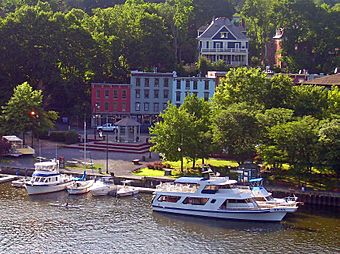Rondout–West Strand Historic District facts for kids
Quick facts for kids |
|
|
Rondout–West Strand Historic District
|
|

Rondout–West Strand waterfront seen from US 9W
|
|
| Location | Kingston, NY |
|---|---|
| Area | 57 acres (23 ha) |
| Built | 1828 |
| Architect | Multiple |
| NRHP reference No. | 79001641 |
| Added to NRHP | August 24, 1979 |
The Rondout–West Strand Historic District is a special historical area in Kingston, New York. It sits right on the shore of Rondout Creek. This district is like a time capsule, with many buildings from the 1800s. It covers about 57 acres and has 259 historic buildings. You might hear people call it "Rondout" or "West Strand" locally.
What's in a Name?
Have you ever wondered where the name "Rondout" comes from? It's a bit of a puzzle! The name "Rondout Creek" comes from an old fort, or "redoubt," that was built near the creek's mouth. The Dutch word for redoubt is "reduyt."
However, in old Dutch records, they often spelled it "Ronduyt" or "Rondout." Some people think the Dutch word "ronduyt" means "frankly" or "positively." Others believe it might have been a simpler way to say "reduyt." Either way, the name stuck!
The Strand
"The Strand" is another important name in this area. In Dutch, "strand" simply means "shore" or "beach." So, the street that runs along the north side of the Rondout Creek has always been called "The Strand." Today, you might hear it called "Strand Street."
A Busy Harbor's History
The Rondout area was always a great spot for a harbor. It's just a short, easy trip up the creek from the Hudson River. This place was first known as Kingston Landing.
But things really took off in 1828. That's when the Delaware and Hudson Canal opened. This canal made Rondout a super important place for shipping. Coal from Pennsylvania and bluestone from the nearby Catskill Mountains were brought here.
The area grew super fast! In 1849, it became its own village called Rondout. It kept growing so much that in 1872, it joined with the Town of Kingston to form the city we know today. By the time the canal closed in 1899, Rondout was full of amazing buildings from all different styles of the 19th century.
From Decline to Revival
Even after the canal closed, the area stayed busy for a long time because of its factories and businesses. But by the 1960s, like many old industrial areas, it started to look a bit run down.
When new roads and bridges were built, some parts of the neighborhood were torn down. This made people realize how important it was to save the rest of the historic buildings.
In 1979, the Rondout–West Strand Historic District was added to the National Register of Historic Places. This means it's recognized as a special place worth protecting.
Today, the waterfront is still active, but now it's mostly for fun! You'll see many boats for recreation. Lots of small shops and restaurants have opened in the old buildings. It's a popular spot for both locals and visitors to explore.



